Seed Classification: Automatic Quality Inspection using Computer Vision
In this article, we motivate the need for computer vision models for automatic the classification of seed species. We demonstrate how our custom models have achieved promising results using "real-world" seed images and describe our future directions for deploying a user-friendly SeedID application.
Introduction

Related work
To read about the fundamentals of computer vision, checkout our page: Artificial Vision: Getting Computers to "See"
Artificial Intelligence (AI) for computer vision has revolutionised our ability to recover valuable insights from visual information. By combining AI algorithms with visual data analysis, computer vision has revolutionized numerous sectors, transforming the way we interact with machines. The advances computer vision research and their integration in industries have created an unprecedented opportunity for enhanced efficiency and accuracy in areas such as: quality control, object detection and classification, surveillance, and more.
Our mission
Here, at the CFIA's AI Lab, we harness the full potential of computer vision models. Our dedicated team of Data Scientists leverage the power of this transformative technology and develop customised solutions tailored to meet the specific needs of our clients.
In this post, we motivate the need for computer vision models for automatic the classification of seed species. We demonstrate how our custom models have achieved promising results using "real-world" seed images and describe our future directions for deploying a user-friendly SeedID application.
At the CFIA AI Lab, we strive not only to push the frontiers of science by leveraging cutting-edge models but also in rendering these services accessible to others and foster knowledge sharing, for the continuous advancement of our Canadian society.
Importance of Canada's seed industry

Manual seed sorting Canada’s multi-billion seed industry has established a global reputation in the production, processing, and exportation of premium-grade seeds across a diverse range of crops. Its success is achieved through Canada’s commitment to innovation and development of advanced technologies, allowing for the delivery of high-quality products that meet both international and domestic needs.
Naturally, a collaboration between a research group from the Seed Science and Technology Section and the AI Lab of CFIA formed to maintain Canada’s role as a reputable leader in the global seed industry.
Background: Quality Control
The seed quality of a crop is reflected in a grading report, whereby the final grade reflects how well a seed lot conforms with Canada’s Seeds Regulations to meet minimum quality standards. Factors used to determine crop quality include: purity analysis and percent of seed germination and disease. The seed’s germination rate and resistance to disease can provide insight into overall seed health. Assessing content purity is essential in ensuring that the crop contains a high concentration of the desired seed material and that it is free from contaminants, such as other crop seeds or weed seeds. Seed inspection also plays an important role in preventing the spread of prohibited and regulated species listed in the Canadian Weed Seeds Order.
Motivation
Presently, the evaluation of a crop’s quality is done manually by human experts. However, this process is tedious and time consuming. At the AI Lab, we leverage advanced computer vision models to automatically classify seed species from images, rendering this process more efficient and reliable.
Overcoming limitations using Computer Vision
Shortage of Analysts

The shortage of expert seed analysts poses a significant challenge in the seed industry. The demand for accurate and efficient seed quality assessment is increasing, but the availability of highly trained analysts is limited. This scarcity can lead to delays in turnaround time for quality assessments, bottlenecks for seed trade, and potential errors in seed classification to regulate species.
How AI helps
Computer vision presents a promising solution to overcome this shortage by effectively analyzing and classifying seeds with minimal human intervention. These models can be trained on vast datasets of seed images, enabling them to recognize patterns, detect variations, and classify seeds based on predetermined quality parameters. By adopting computer vision models in seed analysis, companies and agricultural institutions can alleviate the burden of expert shortages, streamline their operations, and enhance overall productivity. This technology allows Canada to meet the growing demand for seed quality assessments, leading to improved crop yields, reliable seed selection, and ultimately, sustainable agricultural practices.
Time limitations

Manual analysis of seeds is a time-consuming process that poses challenges in terms of efficiency and speed. Seed classification is time-consuming due to the complexity and volume of seed samples. Human experts require significant time and effort to visually inspect and classify each seed, leading to bottlenecks and potential delays in the quality control process.
How AI helps (Time limitation)
Computer vision models offer a solution to these bottlenecks by automating the analysis. By rapidly processing large volumes of seed samples, they significantly reduce the time required for classification enabling faster and more efficient seed classification while maintaining accuracy and consistency.
Cost

Developing expertise in seed analysis demands extensive training and exposure to diverse seed samples, which can be both expensive and time-consuming. The associated costs and time required to train expert analysts include not only the training programs but also the resources required for practical hands-on experience. The time it takes for analysts to gain the necessary proficiency and experience can be lengthy, further exacerbating the shortage of qualified professionals.
How AI helps (Cost)
Computer vision models can offer a more scalable and efficient approach to seed analysis, mitigating the costs and time constraints associated with training expert analysts. Models can be trained on large datasets of seed images, eliminating the need for extensive human training. Additionally, computer vision models can continuously learn and improve over time, rapidly adapting to new seed varieties and enhancing their accuracy. Moreover, they eliminate the subjective biases that may arise from human interpretation, providing an objective and standardized assessment of seed quality.
By leveraging the power of computer vision, the seed industry can overcome the limitations associated with labor shortages, time constraints and training costs, enabling faster and more efficient seed analysis.
Objective: automatic classification of seed species
This project aims to develop and deploy a powerful computer vision pipeline for seed species classification. By automating this classification process, we are able to streamline and accelerate the assessment of crop quality. We develop upon advanced algorithms and deep learning techniques, while ensuring an unbiased and efficient evaluation of crop quality, paving the way for improved agricultural practices.
 Image source:
VideometerLab
Image source:
VideometerLab
Project #1: Multispectral Imaging and Analysis
In this project, we employ a custom computer vision model to assess content purity, by identifying and classifying desired seed species from undesired seed species.
We successfully recover and identify the contamination by three different weed species in a screening mixture of wheat samples.
Our model is customised to accept unique high resolution, 19-channel multi-spectral image inputs and achieves greater than 95% accuracy on held out testing data.
We further explored our model's potential to classify new species, by injecting five new canola species into the dataset and observe similar results. These encouraging findings highlight our model's potential for continual use even as new seed species are introduced.
Data (Project #1)
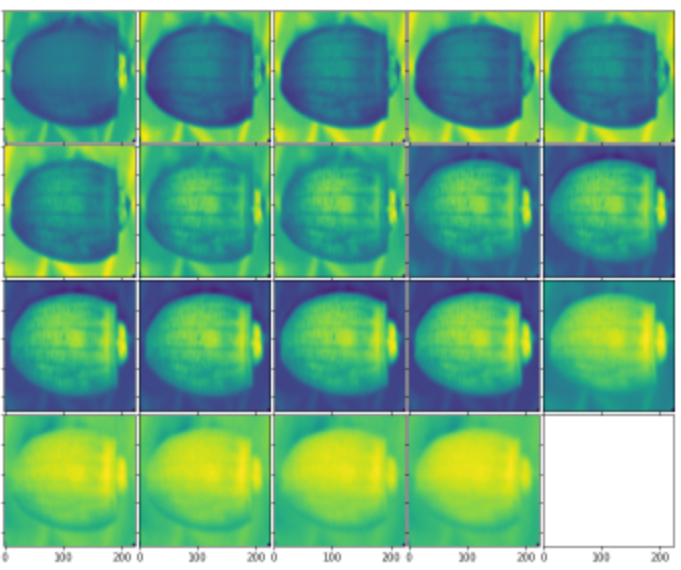 19-channel multi-spectral
image, Carduus nutans
19-channel multi-spectral
image, Carduus nutans
Our model was trained to classify the following species:
- Three different Canada Thistle (weed) species:
- Cirsium arvense
- Carduus nutans
- Cirsium vulgare
- One species of Wheat:
- Triticum aestivum subspecies aestivum
- Five different Canola species:
- Brassica napus subspecies napus
- Brassica juncea
- Brassica juncea (yellow)
- Brassica rapa subspecies oleifera
- Brassica rapa subspecies oleifera (brown)
Results (Project #1)
 >95% model accuracy on
testing datasets
>95% model accuracy on
testing datasets
We show our model is able to correctly identify each seed species with an accuracy of over 95%.
Moreover, when the three Canada Thistle seeds were integrated with the wheat screening, the model achieved an average accuracy of 99.64% across 360 seeds. This demonstrates the model's robustness and ability to classify new images.
Finally, we introduce five new canola species and evaluate our model's performance. Preliminary results from this experiment show a ~93% accuracy on the testing data.
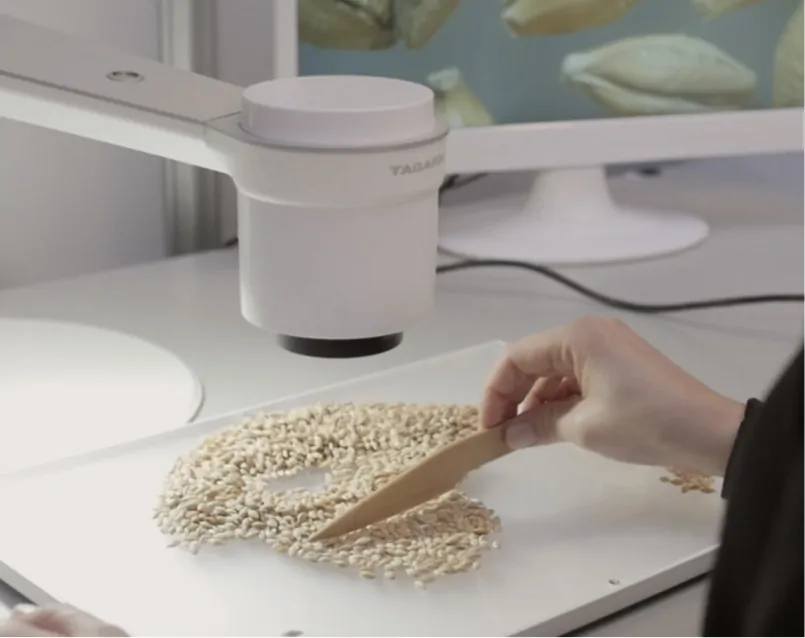 Image source: TAGARNO
microscope
Image source: TAGARNO
microscope
Project #2: Digital Microscope RGB Imaging and Analysis
In this project, we employ a 2-step process to identify a total of 15 different seed species across varying magnification levels.
First, a seed segmentation model is used to identify each instance of a seed in the image. Then, a classification model classifies each seed species instance.
We perform multiple ablation studies by training on one magnification profile then testing on seeds coming from a different magnification set. We show promising preliminary results of over 90% accuracy across magnification levels.
Data (Project #2)
Three different magnification levels were provided for the following 15 species:
- Ambrosia artemisiifolia
- Ambrosia trifida
- Ambrosia psilostachya
- Brassica junsea
- Brassica napus
- Bromus hordeaceus
- Bromus japonicus
- Bromus secalinus
- Carduus nutans
- Cirsium arvense
- Cirsium vulgare
- Lolium temulentum
- Solanum carolinense
- Solanum nigrum
- Solanum rostratum
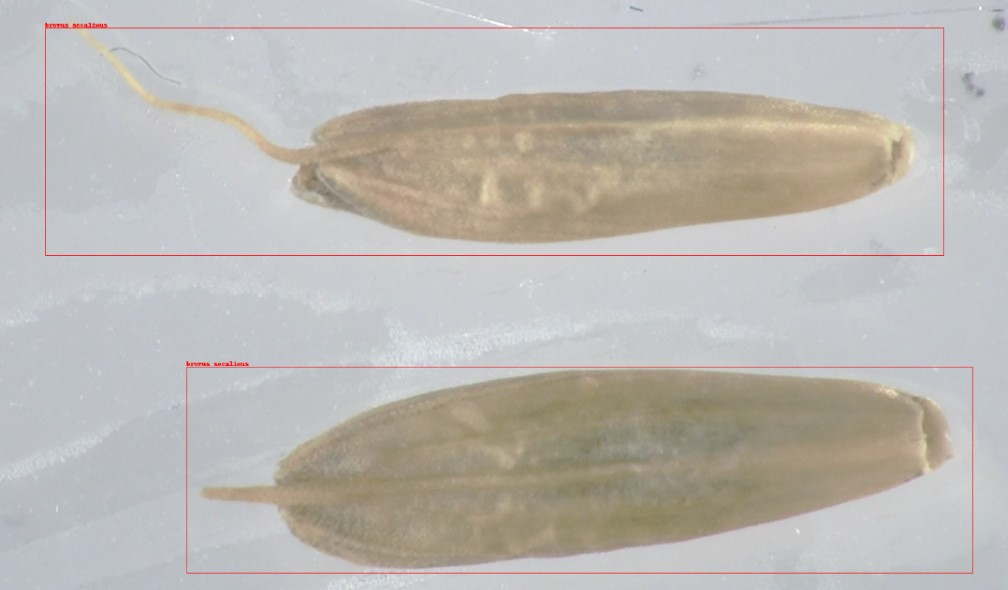 Magnification: 2
seeds/image, Bromus secalinus
Magnification: 2
seeds/image, Bromus secalinus
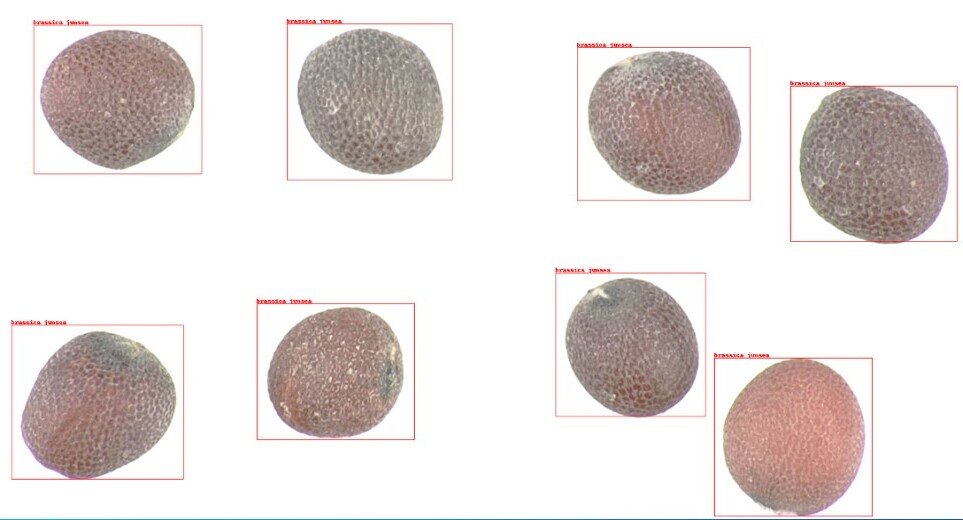 Magnification: 8
seeds/image, Brassica junsea
Magnification: 8
seeds/image, Brassica junsea
Magnification level is denoted by the total number of seeds present in the image, either: 2, 8, or 15 seeds per image.
Results (Project #2)
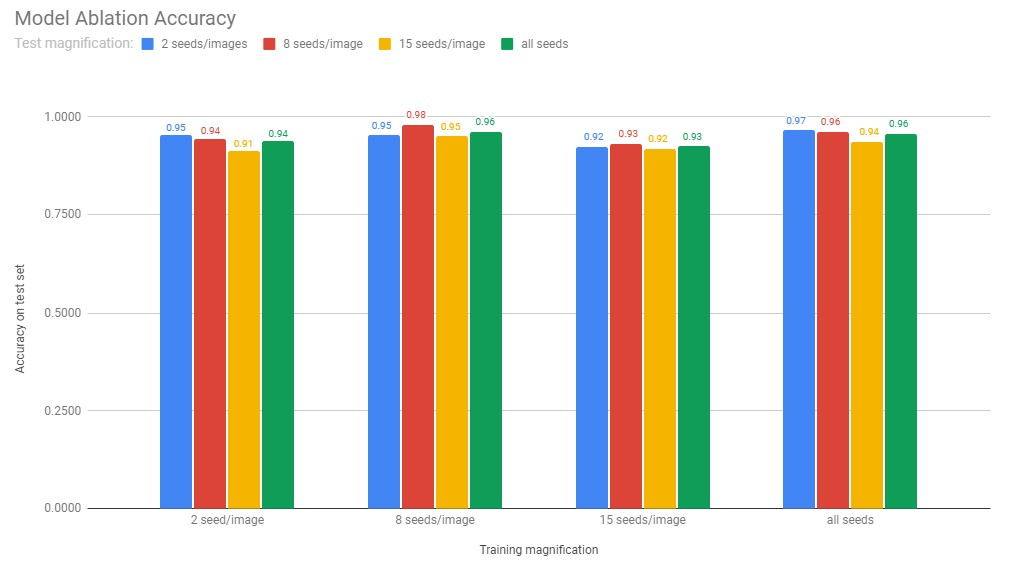 Model test accuracy on a
seed species subset.
Model test accuracy on a
seed species subset.
In order to establish a standardised image registration protocol, we independently train separate models from a subset of data at each magnification then evaluate model performance across a reserved test set for all magnification levels.
Preliminary results demonstrate the model's ability to correctly identify seed species across magnifications with over 90% accuracy.
This demonstrates the model's potential to accurately classify previously unseen data at varying magnification levels.
Challenges
We recognise the challenges associated with data obtained by different methods and modalities. We strive to continue to enhance our model's robustness by incorporating more seed species, improve generalisation across magnification levels, and reduce our 2-step model framework into 1 for better efficiency.
Next steps: Deployment
With the successful development of our advanced computer vision model for seed image classification, our next focus is on deploying this powerful tool in an open-source, user-friendly application: SeedID. Our aim is to provide an intuitive and accessible platform that empowers users of all levels of expertise to effortlessly classify seed samples with high accuracy and efficiency.
To achieve this, we will leverage the capabilities of our computer vision model and combine it with an intuitive user interface, making the application easy to navigate for users of all levels of expertise. The goal is to streamline the seed analysis and classification process and eliminate any technical barriers that may hinder its use.
Our deployment strategy also involves thorough testing and validation to ensure the reliability and accuracy of the seed classification results. Rigorous evaluation will enable us to fine-tune the model and address any potential limitations or biases, guaranteeing robust performance across various seed types and conditions.
Our vision is to empower users with a state-of-the-art seed image classification application that seamlessly integrates computer vision technology. By deploying this open-source, user-friendly solution, we aim to revolutionize the seed industry--promoting efficiency, consistency, and accessibility in seed analysis and contributing to the advancement of agricultural practices worldwide.
Conclusion
 Connecting ideas
Connecting ideas
The seed classification project is an example of the successful and ongoing collaboration between the AI Lab and the Seed Science group at the CFIA. By pooling our respective knowledge and expertise, both teams contribute to the advancement of Canada's seed industry.
We showcase the success of leveraging advanced computational models as tools for image processing tasks and demonstrate their potential to significantly enhance the accuracy and efficiency of evaluating crop quality, ultimately benefiting both the agricultural industry and consumers alike.
Future: Call for collaboration
As Data Scientists, we recognise the importance of open-source collaboration and we are committed to upholding the principles of open science. Our objective is to promote transparency and engagement through open sharing with the public.
By making our application open-source, we invite fellow researchers, seed experts, and developers to contribute to its further improvement and customisation. This collaborative approach fosters innovation, allowing the community to collectively enhance the capabilities of the SeedID application and address specific domain requirements.
